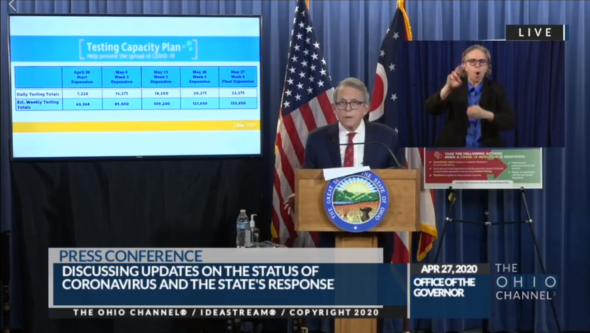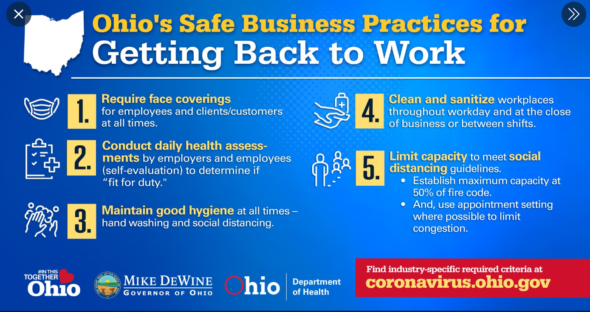
Ohio businesses will reopen in phases, alongside expanded testing and contact tracing in the state, according to Gov. Mike DeWine on April 27.
Governor details phased restart of Ohio economy
- Published: April 28, 2020
Six weeks after closing, some of Ohio’s nonessential businesses are reopening.
Gov. Mike DeWine announced a phased restart of the Ohio economy at his Monday, April 27, briefing, the first specifics offered after an earlier announcement that Ohio would begin to reopen May 1.
Under the restart plan, nonessential medical procedures will be the first to resume, beginning on May 1. Manufacturing, distribution and construction businesses will follow on May 4. Consumer, retail and services will reopen on May 12.
Reopening businesses will be required to follow state safety protocols to reduce the risk of COVID-19 infection. These protocols include protective face masks for employees and customers, daily health assessments for employees, social distancing and other good hygiene practices, frequent sanitizing of the workplace and limiting capacity in workplaces to no more than 50% of what the fire code allows. In addition, employees who can work remotely should do so to limit exposure.
However, in a reversal at the following day’s briefing, DeWine announced that face masks would not be mandated for retail customers. He said he had heard from some Ohioans for whom the mandated measure was offensive. Face masks remain “a strong recommendation” by the state, and retail businesses can choose to require the masks, he added.

DeWine called the new measures “responsible protocols for getting Ohio back to work.”
Not all nonessential businesses have the green light to reopen, however. Dine-in restaurants and bars, personal care businesses, gyms and recreation centers, daycare centers, senior centers and adult day programs all remain closed.
Asked about the delay in reopening restaurants and other businesses, DeWine said that those environments are more difficult to control.
The governor added that he did not yet know when businesses such as hair salons and restaurants would be cleared for reopening. But he pledged to “get these online as fast as we can.”
Restaurants and bars are among the Ohio businesses that have been closed the longest. They were ordered closed on March 15, prior to the state’s stay-at-home order on March 23. The stay-at-home order closed all nonessential businesses and required that Ohioans shelter in place, limiting their activities outside the home to essential errands, such as for groceries and medications.
According to DeWine at Monday’s briefing, Ohio’s stay-at-home order remains in place. In response to a question about whether the return of retail shops “effectively lifted” that order, DeWine said it did not.
Ohio’s stay-at-home order is set to expire on May 1. DeWine did not address whether the order would be extended prior to its expiring.
Ohio’s K–12 schools remain closed, with distance learning continuing through the end of the school year, the governor previously announced.
For kids hoping to head to summer camp, there’s no word yet of whether those programs will be available this summer.
“I’m not ready to make that decision,” DeWine said at Monday’s briefing regarding the opening of pools and summer camps.
Mass gatherings of more than 10 people remain prohibited. DeWine said such gatherings would likely be among the last measures to be lifted because of the difficulty of implementing social distancing.
And while the state won’t be mandating the use of facial coverings, Ohio is recommending that all people wear face masks when out in public.
Testing, contact tracing
Alongside the phased reopening, Ohio is planning to surge its testing and contact tracing in an effort to contain COVID-19.
DeWine said the state needed to “ramp up testing dramatically” as well as expand its contact tracing in order to safely reopen Ohio.
He unveiled the state’s testing capacity plan, which calls for increasing daily testing from 2,228 people on April 29 to 22,275 people by May 27. Under the plan, Ohio would be testing 133,650 people per week by the last week of May. With 11.7 million residents, the state would be testing about 1% of the population on a weekly basis by that point.
Expert opinion varies widely about the level of testing needed to safely contain the virus. According to an April 25 report in the New York Times, estimates of how many people need to be tested weekly to contain the virus in the U.S. range from 0.8% to 21% of the national population.

Ohio has lagged the nation in testing capacity. In common with most states, Ohio has struggled to increase its supply of the reagent and some physical components used in test kits. DeWine last week announced agreements with two manufacturers to increase access to the reagent and testing swabs to support expanded testing in Ohio.
On Monday, the Trump administration came forward with a plan for the federal government to help states ramp up testing, but it remains unclear what the impact of that plan will be. Previous promises of federal support have gone unfilled.
DeWine said he was optimistic that Ohio would be able to expand testing as outlined in the new plan.
“We think we have a real shot at getting these numbers,” he said.
Regarding contact tracing, which refers to identifying individuals who have been in contact with a known infected person and quarantining them to contain the virus’ spread, Ohio will be increasing its contact tracing workforce from 685 local public health workers to an estimated 1,750 workers by June 1, an increase of 1,065. Training will be provided in partnership with Massachusetts-based nonprofit Partners in Health.
DeWine seemed less sanguine about the state’s ability to surge the contact tracing workforce over the next month, calling the June 1 number an “aspirational goal.”
The state’s plan calls for building toward a “deployable state pool” of trained workers. Ohio will provide funding to support the hiring of additional workers at the local level.
Defending phased reopening
Ohio’s phased reopening is set to begin amid mixed progress on the state’s COVID-19 case numbers. While Ohio’s total case count continues to increase, the rate of increase has slowed in recent days. Between Monday and Tuesday, Ohio added 444 new cases, for a total of 16,769 reported cases.
Hospitalizations and ICU admissions have remained about stable over the past week, according to state figures. Deaths have decreased during that time, with an uptick early this week.
Ohio seems to have avoided the hospital surge DeWine previously warned the state could face. While hospitals mobilized to increase their beds and staffing levels, daily case counts remained well below state projections. However, supply of personal protective equipment, or PPE, continues to be limited in the state. It is unclear what effects the ongoing PPE shortage could have on the May 1 resumption of nonessential medical procedures.
Asked whether the state had considered a geographic approach to reopening, with different regions of the state restarting at different times, DeWine said that state officials had discussed such an approach, but rejected it in favor of a statewide phased reopening.
He called a scenario in which each of the state’s 113 local health departments made individual decisions “a disaster.”
In fact, different regions of the state have seen vastly different rates of infection, with urban centers and those home to state prisons where outbreaks have occurred reporting far more cases than rural areas. Marion, Franklin, Cuyahoga and Pickaway lead the state in cases, while Pike, Athens, Monroe and Meigs have the fewest cases. Greene County, with 45 reported cases as of Monday, is about at the midpoint of the state’s 88 counties. All counties now have at least one case.
DeWine was also asked about pressure from some Ohio Republicans to reopen the state more rapidly. In response, he defended his administration’s phased approach as the best way to ensure Ohioans’ safety.
“To throw the doors open on May 1 would be totally irresponsible,” DeWine said.
The phased approach gives the state time to monitor case numbers and build confidence among workers and consumers, he said.
“We don’t want to open up and then fall back,” he said.
DeWine added, “For business to really come back, people have to feel safe.”
The Yellow Springs News encourages respectful discussion of this article.
You must login to post a comment.
Don't have a login? Register for a free YSNews.com account.













No comments yet for this article.